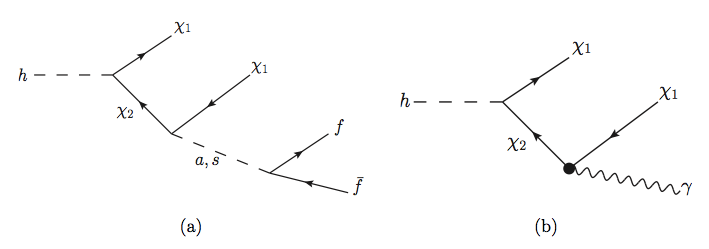For more information about the NMSSM, click here. While both the R- and the PQ-limit lead to a light pseudoscalar as discussed elsewhere, the PQ-limit with mh = 125 GeV typically leads to different exotic Higgs decay phenomenology, in which decays to fermions can be as or more important than decays to scalars [1,2]. When vs >> vu, vd, the dominant tree-level contributions to the masses of the singlet-like scalars and singlino-like fermion ~S are [3,4,1]
 (1)
(1)
 (2)
(2)
 (3)
(3)
 (4)
(4)
 Figure 1: Two significant fermionic decay topologies of the SM-like Higgs boson in the
Figure 1: Two significant fermionic decay topologies of the SM-like Higgs boson in thePQ symmetry limit. Left (a): depending on whether min{ms, ma} exceeds mχ2 − mχ1, a(s) may or may not be on shell. Right (b): to be non-negligible, the radiative χ2 decay requires min{ms, ma} > mχ2 − mχ1.)
Summary:
The PQ-limit of the NMSSM yields semi-invisible exotic Higgs decays into pairs of light neutralinos, most typically h→ χ2χ1 or h→ χ2χ2, with χ2 → χ1 a, χ1 s, and a,s→ (f―f, gg, γγ). This yields final states of the form (b―b)+MET, (ττ)+MET, (b―b) (b―b)+MET, (ττ)(ττ))+MET, and the rarer but cleaner γ+MET, (2,4)μ+MET, (μμ)(b―b)+MET. Depending on the spectrum, the visible particles may be collimated or isolated. Current experimental constraints and future prospects for a subset of these decays are discussed on the γ+MET, bb+MET, 2γ+MET, ττ+MET, and collimated/resonant leptons pages.
References
[1]P. Draper, T. Liu, C. E. Wagner, L.-T. Wang, and H. Zhang, Dark Light-Higgs Bosons, Phys. Rev. Lett. 106 (2011) 121805, [arXiv:1009.3963].
[2]J. Huang, T. Liu, L.-T. Wang, and F. Yu, Supersymmetric Exotic Decays of the 125 GeV Higgs Boson, Phys. Rev. Lett. 112 (2014) 221803, [arXiv:1309.6633].
[3]P. Ciafaloni and A. Pomarol, Dynamical determination of the supersymmetric Higgs mass, Phys.Lett. B404 (1997) 83-88, [hep-ph/9702410].
[4]D. Miller, S. Moretti, and R. Nevzorov, Higgs bosons in the NMSSM with exact and slightly broken PQ-symmetry, [hep-ph/0501139].
[5]B. A. Dobrescu and K. T. Matchev, Light Axion Within the Next-to-Minimal Supersymmetric Standard Model, JHEP 0009 (2000) 031, [hep-ph/0008192].
[6]R. Dermisek and J. F. Gunion, The NMSSM Close to the R-symmetry Limit and Naturalness in h → aa Decays for m_a < 2m_b, Phys.Rev. D75 (2007) 075019, [hep-ph/0611142].
[7]www.th.u psud.fr/NMHDECAY/nmssmtools.html.
[8]U. Ellwanger and C. Hugonie, NMSPEC: A Fortran code for the sparticle and Higgs masses in the NMSSM with GUT scale boundary conditions, Comput.Phys.Commun. 177 (2007) 399-407, [hep-ph/0612134].
[9]M. Muhlleitner, A. Djouadi, and Y. Mambrini, SDECAY: A Fortran code for the decays of the supersymmetric particles in the MSSM, Comput.Phys.Commun. 168 (2005) 46-70, [hep-ph/0311167].
[10]D. Das, U. Ellwanger, and A. M. Teixeira, NMSDECAY: A Fortran Code for Supersymmetric Particle Decays in the Next-to-Minimal Supersymmetric Standard Model, Comput.Phys.Commun. 183 (2012) 774-779, [arXiv:1106.5633].
File translated from TEX by TTH, version 4.03. On 15 Dec 2013, 23:20.